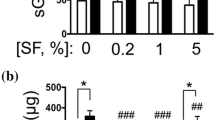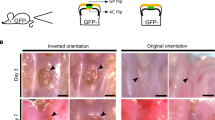Abstract
Most cartilage explant culture studies assume conventional serum-supplemented growth media are biologically equivalent to the natural synovial fluid which baths cartilage in vivo. Few studies have systematically compared the effects of serum versus synovial fluid in culture. To address this assumption we conducted a series of studies to determine if cartilage matrix synthesis is significantly different in serum-based versus synovial fluid-based media. Normal bovine cartilage explants were cultured in DMEM either alone or supplemented with bovine serum or bovine synovial fluid. Matrix synthesis was measured with radiolabeling techniques. We then compared responses to insulin-like growth factor I (IGF-I, a stimulator of matrix synthesis), and interleukin-1β (IL-1β, an inhibitor of matrix synthesis). We observed significantly lower matrix synthesis activity in synovial fluid versus serum. Caution shoud be used in extrapolating studies of cartilage grown in media supplemented with serum rather than synovial fluid.
Similar content being viewed by others
References
Bird JL, Wells T, Platt D, et al. (1997). IL-1 beta induces the degradation of equine articular cartilage by a mechanism that is not mediated by nitric oxide. Biochem Biophys Res Commun 238: 81-85.
Bonassar LJ, Grodzinsky AJ, Frank EH, et al. (2001). The effect of dynamic compression on the response of articular cartilage to insulin-like growth factor-I. J Orthop Res 19: 11-7.
Fibbi G, Serni U, Matucci A, et al. (1994). Control of the chondrocyte fibrinolytic balance by the drug piroxicam: relevance to the osteoarthritic process. J Rheumatol 21: 2322-2328.
Hascall VC, Calabro A, Midura RJ, et al. (1994). Isolation and characterization of proteoglycans. Methods Enzymol 230: 390-417.
Hollander AP, Atkins RM, Eastwood DM, et al. (1991). Degradation of human cartilage by synovial fluid but not cytokines in vitro. Ann Rheum Dis 50: 57-58.
Ismaiel S, Atkins RM, Pearse MF, et al. (1992). Susceptibility of normal and arthritic human carticular cartilage to degradative stimuli. Br J Rheumatol 31: 369-373.
Jones IL, Klamfeldt A, McGuire MB (1982). Enhanced breakdown of bovine articular cartilage proteoglycans by conditioned synovial medium. The effect of serum and dextran sulphate. Scand J Rheumatol 11: 41-46.
Klamfeldt A (1986). Incorporation of [35S]sulphate and [3H]thymidine into isolated bovine articular chondrocytes in vitro. Effect of autogenous conditioned synovial medium. Scand J Rheumatol 15: 7-12.
Klamfeldt A (1984). Synthesis of articular cartilage proteoglycans by isolated bovine chondrocytes. Effect of autogeneous conditioned synovial medium in vitro. Agents Actions 14: 58-62.
Lee DA, Salih V, Stockton EF, et al. (1997). Effect of normal synovial fluid on the metabolism of articular chondrocytes in vitro. Clin Orthop: 228-238.
McQuillan DJ, Handley CJ, Campbell MA, et al. (1986). Stimulation of proteoglycan biosynthesis by serum and insulin-like growth factor-I in cultured bovine articular cartilage. Biochem J 240: 423-430.
Neidel J, Zeidler U (1993). Independent effects of interleukin 1 on proteoglycan synthesis and proteoglycan breakdown of bovine articular cartilage in vitro. Agents Actions 39: 82-90.
Nuver-Zwart I, Schalkwijk J, Joosten LA, et al. (1988). Effects of synovial fluid and synovial fluid cells on chondrocyte metabolism in short term tissue culture. J Rheumatol 15: 210-216.
Ostensen M, Veiby OP, Raiss R, et al. (1991). Responses of normal and rheumatic human articular chondrocytes cultured under various experimental conditions in agarose. Scand J Rheumatol 20: 172-182.
Platt D, Bayliss MT (1994). An investigation of the proteoglycan metabolism of mature equine articular cartilage and its regulation by interleukin-1. Equine Vet J 26: 297-303.
Sah RL, Chen AC, Grodzinsky AJ, et al. (1994). Differential effects of bFGF and IGF-I on matrix metabolism in calf and adult bovine cartilage explants. Arch Biochem Biophys 308: 137-147.
Swann DA (1978). Macromolecules of synovial fluid. In: Sokoloff L, Ed. The Joints and Synovial Fluid, pp. 407-435. London: Academic Press.
van de Lest CH, van den Hoogen BM, van Weeren PR, et al. (2000). Loading-induced changes in synovial fluid affect cartilage metabolism. Biorheology 37: 45-55.
Van den Hoogen BM, van de Lest CH, van Weeren PR, et al. (1998). Loading-induced changes in synovial fluid affect cartilage metabolism. Br J Rheumatol 37: 671-676.
Author information
Authors and Affiliations
Rights and permissions
About this article
Cite this article
Martin, J.A., Wilkey, A.L. & Brand, R.A. Cartilage extracellular matrix metabolism differs in serum and synovial fluid. Methods Cell Sci 24, 139–143 (2002). https://doi.org/10.1023/A:1024468101796
Issue Date:
DOI: https://doi.org/10.1023/A:1024468101796




